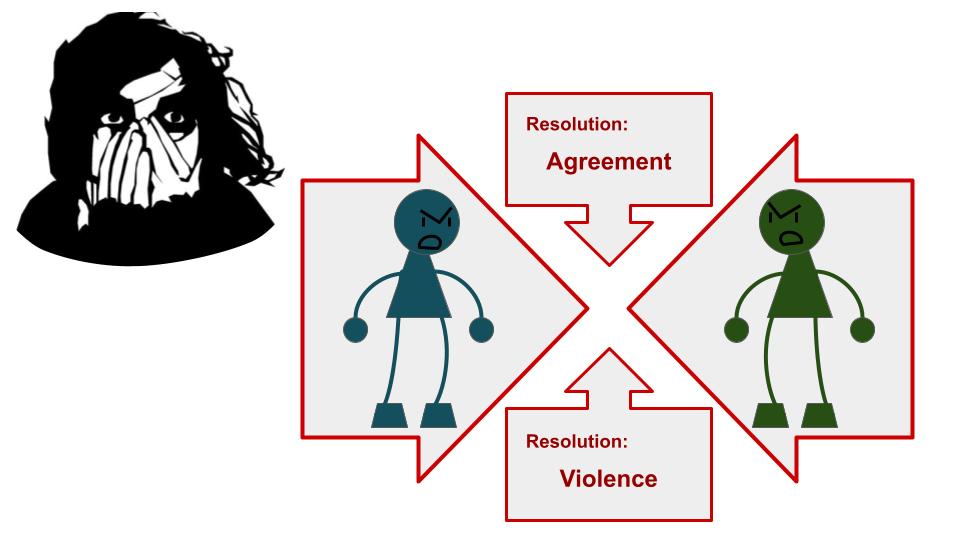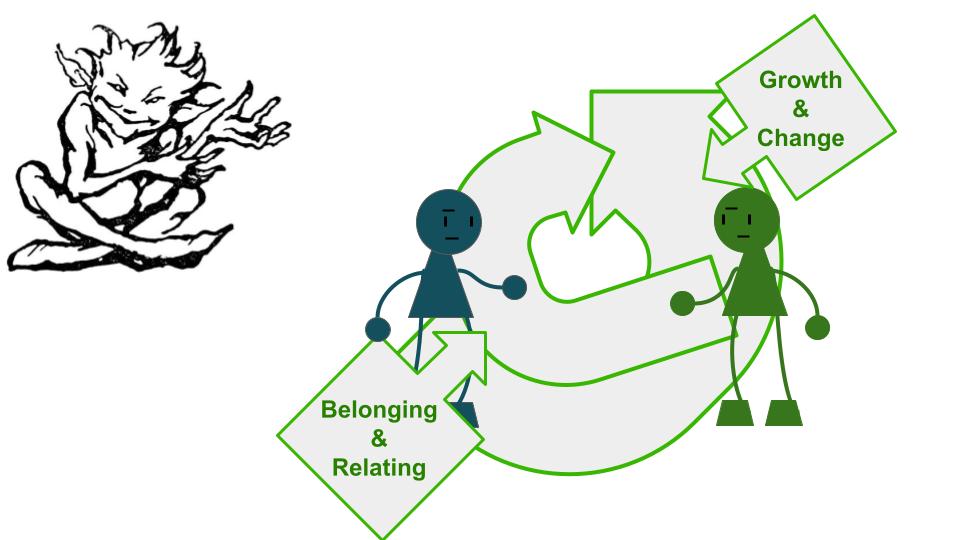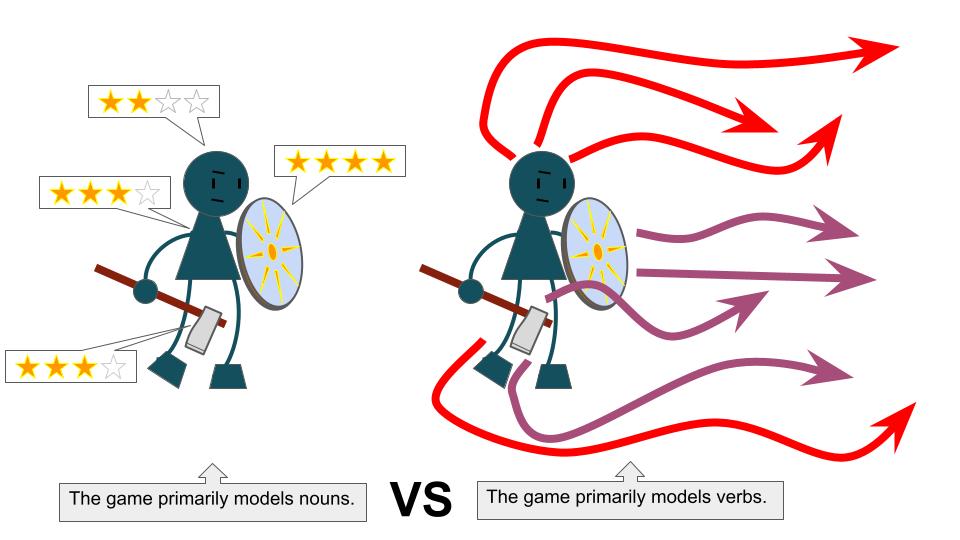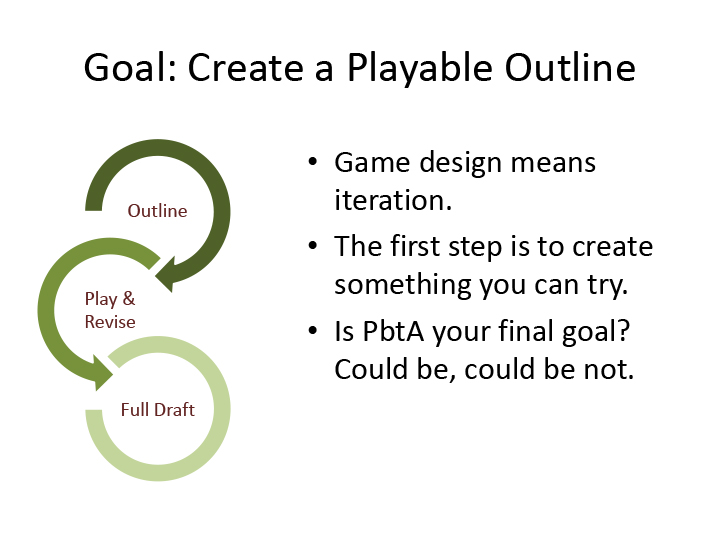Using Apocalypse World to Outline and Draft Your Own RPG
Here in Part 10, I develop the idea of underlying models further, with 2 solid examples and 1 tentative one.
This article was made possible by the generous support of my patrons. Please consider joining them by supporting me on Patreon.
Model #1: Apocalypse World’s Conflict Model

Apocalypse World is based on a model of implicit conflict between fictional characters, and consent and agency between the players at the table.
Principles of the model:
- Characters are competent to act independently, and are compelled into action by their own self-interests, best interests, drives, and convictions.
- Because characters’ interests and drives aren’t all compatible, a character in action will, sooner or later, come into conflict with other characters.
- Conflicts between characters, uninterrupted, escalate to violence, or else resolve with a mutual agreement.
- The game’s rules are concerned both with what the characters are able to do and what they choose to do: which conflicts they choose to pursue, how far they’re willing and able to take them, what and when they’ll compromise, and whether they ultimately win the resolutions they hope for.
- In general, the players’ characters are allies, willing to support and compromise with one another for their mutual good, but strict unity isn’t necessary and conflict between them isn’t uncommon.
- Conflict between characters doesn’t require and shouldn’t become conflict between players. Players can and should work mutually together to discover, escalate, and resolve the conflicts between their characters.
- The role of the game’s rules is to allow and promote conflict, escalation, and resolution between the characters, while protecting and maintaining strong creative unity between the players.
You can read more about Apocalypse World’s underlying model back in Part 3 of this series.
We Play to Find Out…
In Apocalypse World, we play to find out what the characters make of their world, both what they choose to make of it, and what they’re able to make of it after all.
Basic Move Examples
From AW:Burned Over:
Read a Situation
When you read a charged situation, roll+Sharp. On a 10+, ask the MC 3 questions right now. On a 7–9, ask the MC 1 question. They have to answer frankly, and when you’re acting on their answers, take +1 to any rolls you make.
• Who’s in control here?
• What’s my best way in / out / around / through?
• Who or what poses the biggest threat to me?
• Who or what represents the best opportunity for me to do [x]?
• What should I be on the lookout for?
On a miss, the MC might have you ask 1 anyway, but be prepared for the worst.
The selection of questions in reading a situation is designed to help you clarify, understand, and navigate the conflicts you’ve entered into. Whose interests are you coming up against, what avenues for escalation are available to you, and how might they escalate against you?
Confront Someone
When you confront someone, tell them frankly what’s wrong and what to do about it, or just get in their face, and roll+Aggro. On a 10+, they have to choose: do what you say, or defy you and push you back. On a 7–9, if they don’t want to obey you or defy you, they can try to stall, make excuses, or pass the buck. Either way, choose whether and how to follow through. On a miss, be prepared for the worst.
Attack Someone
When you attack someone, roll+Hard. On any hit, you inflict harm as established. On a 10+, choose 2 of the following against your enemy. On a 7–9, choose 1. On a miss, be prepared for the worst.
• Inflict terrible harm: Inflict +1harm.
• Seize hold of something: Name it; you have definite hold of it.
• Get them out of your way: You knock them down, drive them away, or fight past them.
• Impress, frighten, or dismay them: Ask the MC how this changes their morale and intentions.
• Pin them down: They’re immobilized, cornered, or boxed in, and can’t move freely.
In Apocalypse World, both confronting someone and attacking them are direct conflict-escalating moves.
Model #2: Under Hollow Hills’ Model of Relating

In Under Hollow Hills, your character isn’t a bundle of vision, self-interest, and survival instincts, armored up and armed to the teeth. Instead, your character is a bundle of what do I want? and what do I have to give?
Instead of being in implicit conflict with everyone else in the world, your character is poised to give and receive, to help and be helped, to change others and to be changed by them. Everyone you meet isn’t your enemy or enemy-to-be; everyone you meet is an opportunity to reach out, connect, or discover your own boundaries.
The model underlying Under Hollow Hills is a relationship cycle. In the broadest strokes, it works like this:
- You meet another character. Maybe you hear about them first. You get and make a first impression.
- Time, circumstances, and inclination allowing, you act both to learn more about them and to reveal more of yourself to them.
- This leads you to a mutual understanding of one another, deeper than your first impressions and first interactions.
- From here you have a choice. You can withdraw from them, rebuff them, or draw closer to them still. They have the same choice too!
- Whichever you choose, this changes you, changes them, and changes your relationship. Furthermore, the circumstances, the place, the season is changing around you. Eventually…
- You learn something new about them, from your changed perspective in your changed circumstances. Maybe you’re surprised, maybe delighted, maybe dismayed, maybe confused or hurt. Maybe they’re sorry and you’re considering giving them another chance. You’ve entered into the cycle again.
No matter how close you come to someone, this model says, because you’re changing, they’re changing, and the world is changing around you, you’re always meeting them anew. There’s always more to learn. There’s always closer you can become, and there’s always the chance — the opportunity or the danger — that you’ll draw apart instead.
This cycle of relationships, not a model of implicit conflict, is the foundation for Under Hollow Hills. You can read more about it in Part 6 of this series.
We Play to Find Out…
In Under Hollow Hills, we play to find out how the characters treat each other when times are good, and how they treat each other when times are bad.
Basic Move Examples
From Under Hollow Hills:
Open Up to Someone
When you open up to someone, roll. On any hit, you capture their attention and they must hear you out. On a 10+ hit, choose 2 of the following. On a 7–9 hit, choose 1.
• Reveal to them what you’d like them to do. If they accede, offer them a reward or a favor, but if they refuse, you may consider it an insult.
• Reveal to them something you’re considering, and judge their reaction to it. Ask their player what they think; they have to tell you. This can be implicit or explicit, and they may or may not realize what they’ve revealed.
• Offer them something, explicitly or implicitly. If they accept it, they’re beholden to you, in proportion, as you judge it, but if they refuse, you may consider it an insult.
• Confide in them or explain something to them. Tell them what you reveal and ask them how they take it. They must answer honestly.
On a miss, ask the MC what goes wrong. They might have you choose 1 anyway, but be prepared for the worst. Perhaps you’ve made yourself beholden to them.
Opening up to someone lets you put pressure on your relationship, but doesn’t assume that conflicts exist between you. It can reveal conflicts when they exist, but it can also strengthen or complicate your relationship when your interests don’t conflict.
Put Someone Off
When you put someone off, roll. On any hit, they must back off and give you time and space. On a 10+ hit, they have to physically leave or let you leave yourself. On a 7–9 hit, they can remain nearby, if they choose, and follow along behind you if you leave. On a miss, ask the MC what goes wrong. Perhaps you’ve insulted them.
Putting someone off is as blunt a de-escalatory move as confronting someone is escalatory.
Sniff the Wind
When you sniff the wind, roll. On any hit, ask the MC questions, which they must answer truthfully. On a 10+ hit, ask 2. On a 7–9 hit, ask 1.
• What’s coming this way?
• What’s here that I haven’t yet seen?
• Whose territory is this? Whose doing?
• If I trust my feet to carry me to safety, where will they take me?
• How could I make myself invisible here, how could I go unnoticed?
• If I trust my nose to lead me to the heart of this, where would it take me next?
On a miss, ask the MC what goes wrong. They might have you choose 1 anyway, but be prepared for the worst. Perhaps you’ve disturbed something or someone without realizing.
Sniffing the wind is Under Hollow Hills’ version of reading a situation. Its questions are more conflict-neutral, including questions that help you avoid and escape conflict, and that help you understand situations with more nuance, as well as help you understand whose interests conflict.
Model #3: an Adventure Model

How about a model for an adventure game? What would it look like?
- The characters have thrown in together to seek and face adventure. They find themselves in a variety of circumstances, often not of their choosing. Often, they find themselves in situations where their own personal ambitions and pursuits barely apply at all, where they must struggle instead just to get through and come out on top.
- While some of their adventures certainly include conflict and violence, they also include challenges, hardships, mysteries, insensate dangers, and so on. Difficult, challenging, and dangerous tasks are as important to the game as conflicts of interest between characters, or moreso. The characters must be prepared to face all kinds of action.
- A character, then, isn’t a bundle of implicit personal conflicts, armed with angles of attack, but a bundle of competency and resources they can bring to bear on the (often impersonal) problems they face.
- In Apocalypse World, it’s quite easy to escalate and change the arenas in which your conflicts play out. When you’re losing an argument, throw a punch; when you’ve been backed into a corner, talk fast. Under this model, though, it’s often difficult or impossible: while you might employ any number of strategies to tackle the problems you face, when it comes down to it, there’s no talking your way past a locked door, no making a show of force against a raging fire, no seeking common ground with a sinking ship.
- The players should share their characters’ experiences of exploration and discovery. For the most part, they shouldn’t have a hand in creating the environments or situations they find themselves in. Situations should substantially preexist the characters’ involvement.
- The rules concern themself with the practical consequences of the characters’ actions, including their successes and failures, their overcoming or succumbing to dangers, and the ways they set themselves up for future success or danger.
- The rules don’t especially highlight or put pressure on the characters’ relationships. They don’t expect the characters’ relationships to change over the course of play, and don’t use changing or conflicted relationships as en especial source of drama.
- The rules also don’t make a priority of transparency between GM and players. In fact, the GM should know behind-the-scenes facts that the players don’t, because in any situation, there are likely to be behind-the-scenes facts that the players’ characters haven’t uncovered.
We Play to Find Out…
In this game, we play to find out how the characters deal with the dangers, mysteries, and situations they encounter, and whether they can prosper or indeed survive them.
This Looks Familiar, Though
This is a common model in roleplaying at large, yes. Possibly the majority model. If it looks familiar, it should! Nevertheless, I don’t believe it’s well-explored yet in PbtA games.
The challenge and the opportunity, as I see it, is to use this model to create a verb-based, not noun-based, game.

Basic Move Examples
From a game in development:
Get to Work
When you get to work, tell the GM what you’re trying to do and how you’re going about it. Ask them what you can accomplish on a 10+ hit and what you can accomplish on a 7–9 hit, then roll your Bold. On that hit, that’s what you accomplish. Pass the initiative to someone else while you’re working, and you get it back when you’ve finished your work.
On a miss, ask the GM what goes wrong instead.
You can ask what you can accomplish on a 12+ hit or a 13+ hit as well, if you find that the 10+ hit falls short.
In this game, getting to work is the crucial move for taking on difficult, dangerous, or challenging tasks, conflicts altogether aside.
Prepare Yourself
When you take a moment to prepare yourself for what’s coming, roll your Patient. On a 10+ hit, choose 2 of the following. On a 7–9 hit, choose 1. You can tell everyone what you’ve chosen, or simply note it.
• I’m ready to strike.
• I’m ready to defend myself.
• I’m ready to run.
• I’m ready to act.
• I’m ready to face [x].
• I’m ready to do [x].
• I’m ready to learn.
• Another of your own. Check it with the GM, or go back and choose 1 of the above.
When you get the initiative, if you do what you’re ready to do, you have an edge.
On a miss, ask the GM what goes wrong instead.
Preparing yourself emphasizes that you don’t know what’s coming, but you can plan, guess, think through the possibilities, and hedge your bets against the worst dangers. It highlights danger and uncertainty, where Apocalypse World is eager to crystallize and clarify its threats and conflicts.
Read a Situation
When you take a second to read a charged situation, roll your Quick. On any hit, ask 1 of the following questions. The GM or the other player should answer honestly.
• What’s about to happen here? How can I tell?
• What do my instincts tell me?
• What’s my best way in, out, around, over, or through? How can I tell?
• Who here can I count on? How do I know?
• What is [x] in a position to do?
• I want [x] to happen. What might I do to make it go that way?
• A question of your own. If the GM or the other player answers it, it stands. Otherwise, go back and choose 1 of the above.
On a 10+ hit, in addition, choose 1:
• Ask another question or 2.
• Hold or seize the initiative. What do you do now?
Otherwise, pass the initiative to someone else while you consider things.
On a miss, ask the GM what goes wrong instead.
The selection of questions in this game’s version of reading a situation are designed for action and danger, including conflicts when they’re present but not so exclusively assuming them.
By including “how can I tell?” and “how do I know?” this version also highlights the PC’s immediate senses and observations, bringing the player’s and the character’s experience into closer alignment.
Q. Just to be clear, are these the only 3 possible models?
A. Of course not! Absolutely not. There are as many possible models as we can collectively conceive.
Thanks, everyone!
If you have any questions, I love to answer them. Hit me up, it’ll be my pleasure.
Past Installments:
- Back in Part 1, I laid out Apocalypse World’s philosophy and foundation, described the fit and purpose of its systems, and talked about which features are central to its workings and which aren’t.
- Then in Part 2, I walked through the beginnings of taking Apocalypse World’s parts and using them as the basis for a whole new game.
- In Part 3, I dived back into Apocalypse World’s basic moves. I went through them one by one to talk about how and why they work the way they do.
- In Part 4, I talked about playbooks, by request. What are they, do you want them in your game, and what are the alternatives?
- In Part 5, I took a quick aside to talk about some different ways that moves can fit into the conversation of play.
- In Part 6, I used an Ursula K. LeGuin quote — you probably already know the one! — as an outline for alternative models to Apocalypse World’s model of conflict.
- Part 7’s a good old-fashioned Q&A, in rounds: Round 1, Round 2, Round 3 (the lightning round!), & Q&A Round 4 (the Final Round!)
- In Part 8, I shared my six best, most reliable tricks for drafting interesting moves.
- In Part 9, I laid some groundwork for the idea of underlying models by pointing out a crucial feature of Apocalypse World.
Next Installments:
- In Part 11, I explore a few of the dice systems we’ve used in our PbtA games.
Reminder: The Goal is to Create a Playable Outline


Keftiu says:
I’m *giddy* to hear some thoughts on Firebrands – thank you for this insightful read!
Dylan says:
“By including “how can I tell?” and “how do I know?” this version also highlights the PC’s immediate senses and observations, bringing the player’s and the character’s experience into closer alignment.”
Hi Vincent! I love this addition. One thing I appreciated about the design of Apocalypse World is how fluidly you can zoom in to moment to moment interaction and zoom out to long periods of downtime earning barter while the player still feels their character’s experiences.
Would this extra question be something you’d add to your Read a Situation (and potentially Read a Person) in a theoretical Burned Over v2024 (*crosses fingers*) or is there something about it that makes it better for this in development game?
I say this planning to possibly add it into my Basic Moves sheet when I plan to run Apocalypse World Burned Over next year.
Vincent Baker says:
We may add it to Burned Over, yeah, if we can find space on the page. It reflects how I GM those moves anyway.
I’d say go ahead and add it to your own sheet for sure.
Teoriakatsaus #142 – ropeblogi says:
[…] Powered by the apocalypse, part 10: 3 underlying models, kirjoittajana Vincent Baker, selittää miten Maailmanlopun voimaannuttamat pelit käsittelevät ristiriitoja, kolmen eri esimerkin kautta. https://lumpley.games/2023/12/17/powered-by-the-apocalypse-part-10-3-underlying-models/ […]
Jack Davis says:
I have to say, I really love the Under Hollow Hills system of interactions, as it gives characters a wide variety of ways to interact with each other beyond what I’ve seen in other games.
I hope we get to see more of that game, as it’s one of my favourites.